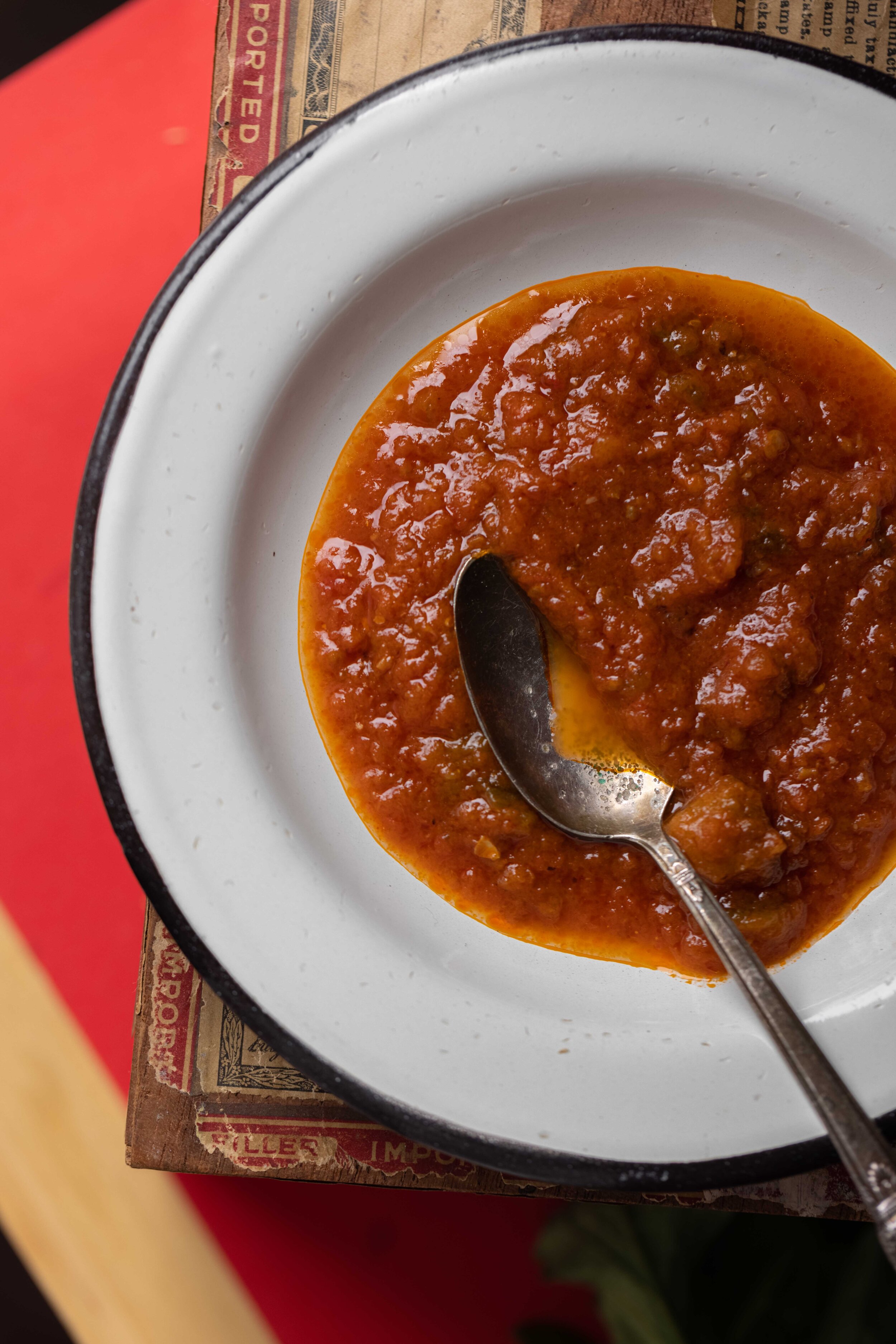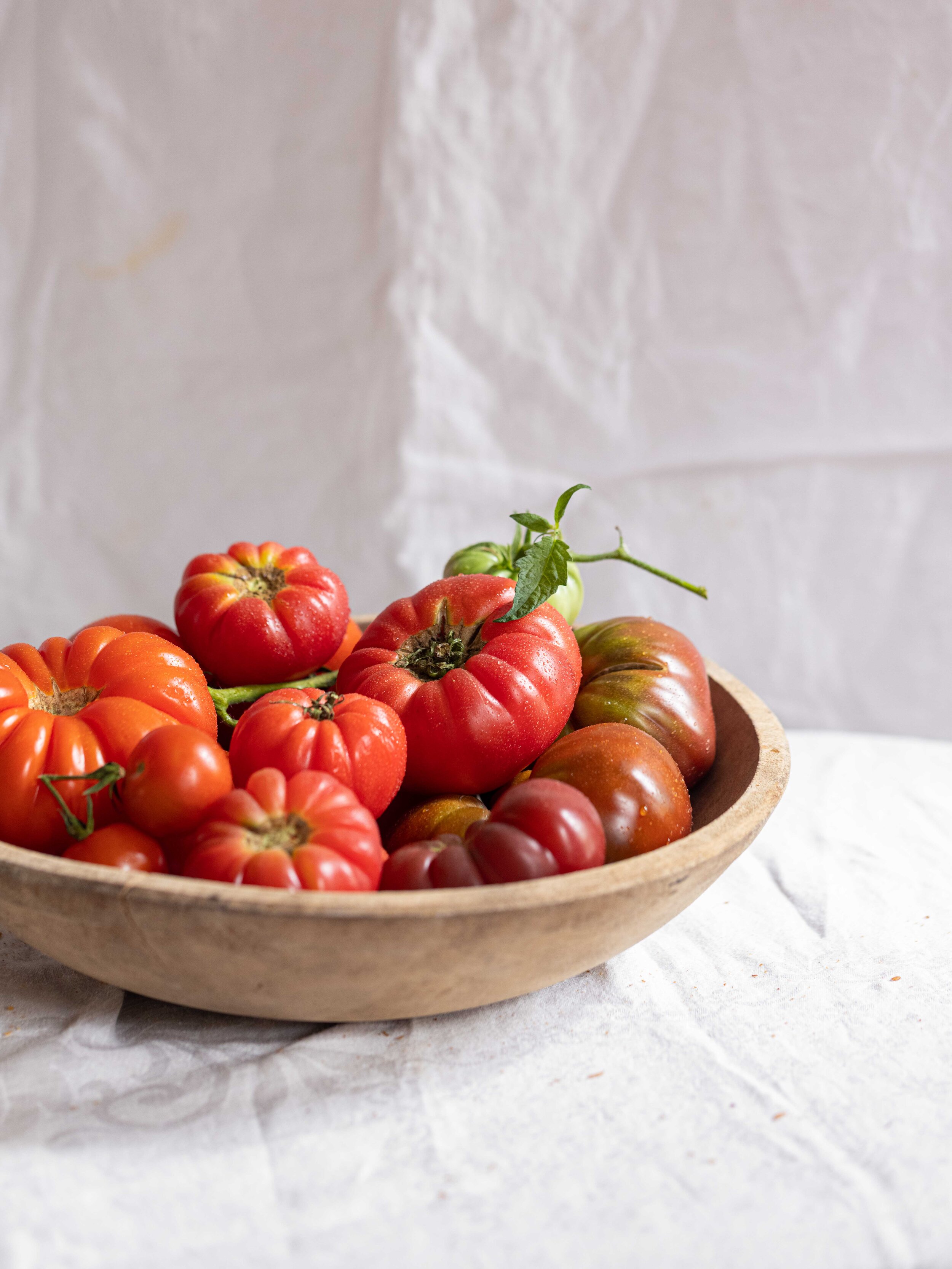MATBUCHA
{An everyday tomato condiment}
What is Matbucha?
At the height of summer, when days grow hot and long, the garden explodes with sun-hungry vegetables -- ruby tomatoes, crisp bell peppers, and sultry eggplants -- and a fragrant jungle of herbs. From ratatouille in France and lecsó in Hungary, to Italy’s glorious tomato sauces and Mexico’s many salsas, people all over the world celebrate dishes that capture the season’s bountiful riot of produce.
“The elements are simple - little more than peak-season tomatoes, hot green chiles, and garlic, with patience as the secret ingredient.”
For Moroccan Jews, summer means matbucha. The elements are simple - little more than peak-season tomatoes, hot green chiles, and garlic, with patience as the secret ingredient. Cooked together low and slow, these ingredients transform into a luscious, deeply concentrated and intensely flavored ‘cooked salad’ or sauce that pairs effortlessly with just about everything. Matbucha is an integral part of the Moroccan Jewish mezze table, an eye-catching bowl of glistening red in a sea of dips and spreads. It is also an everyday condiment (so much so that some families refer to it as ‘Moroccan ketchup’!), and a flavorful base for countless savory dishes.
Growing up, matbucha was a staple of New York Shuk Culinary Director and Co-Founder, Ron Arazi’s Moroccan family table in Israel. His mom’s weekly batches disappeared in the blink of an eye. “When her matbucha was ready, she would spoon it into jars, then we would dive into the cooking pot, warm challah in hand, to sop up every leftover bit!” Ron recalls.
Building on Ron’s family traditions, New York Shuk’s Signature Matbucha begins with iconic Jersey tomatoes and roasted Hatch chiles, and pairs them with just enough garlic and preserved lemon to amplify their summer sun-kissed essence. The jammy spread is rich and vibrant, with just the right touch heat. Those who prefer a milder sauce can opt for Matbucha with Olives and Mint -- a playful variation on the classic that features briny Manzanilla olives, fresh mint, and a hint of turmeric
Our matbuchas bring summer vibes to your pantry all year round. They are equally suited for enjoying straight from the jar, or to amp up your next culinary creation.
“Our matbuchas bring summer vibes to your pantry all year round.”
VIDEOS
Beyond excited we get to share with you this beautiful short film by Liza deGuia. Find more behind-the-scenes intel about Matbucha and New York Shuk in Liza’s full blog post. Click below to watch our story.
How to Pronounce Matbucha?
The process of bringing to life a product that most people have never heard of, let alone how to pronounce it (mat-boo-HA) is a tough one. In order to help educate how to say it, we went to the streets of Brooklyn and had people pronounce Matbucha for us. Here is how they did…
“Equally suited for enjoying straight from the jar, or to amp up your next culinary creation.“
Matbucha’s Origins
The name matbucha is derived from the Arabic word for cooking (tabkh), and essentially translates to “cooked stuff.” It is also called salade cuite or “cooked salad” in French, as well as frita, madurma, or salade juive.
Matbucha’s origins likely date as far back as the 16th or 17th centuries, when merchants traveled from New World to Old, bringing tomatoes from Mexico to Europe and North Africa. To preserve the short tomato season, just as Italians gently cook fresh tomatoes to use throughout the year as a base for sauces and stews, Jews from Morocco, Libya, Algeria, France, Israel and beyond simmer tomatoes with peppers and spices to make the delicious ‘cooked salad’ and sauce known as matbucha.
Variations of matbucha are found across North Africa and the Middle East: Some cooks flame-char their chiles, then slip off the skins before adding the sweet pepper ‘meat’ to the pot of tomatoes. Some employ spices, such as sweet or smoked paprika, cumin, or caraway, while others don’t use any spice at all. Each family has their ideal ratio of tomatoes to peppers, and some might swap fresh tomatoes for canned during the colder months. No two matbucha recipes are exactly the same - and yet, the slow-cooked richness and thick, jammy texture is a comforting constant.
In the 1950s, Moroccan immigrants to Israel (and elsewhere) brought their matbucha recipes with them as they settled into new homelands. Ron’s mother, Linor, recalls that since tomatoes were scarce at the time, her parents, Rachel and Aharon, took to the garden to grow their own, along with hot peppers and more, so the family could continue to enjoy matbucha. Cookbook author, Kim Kushner, remembers her Moroccan grandmother’s matbucha as “minimalistic comfort food at it’s finest” - something special to always have on hand to serve loved ones who might drop by on a moment’s notice. Arielle Mamiye, the culinary director for the Jewish Food Society, says matbucha was, “the bread and butter of my savta’s (grandmother’s) household.” And award-winning author, Joan Nathan, a self-professed lover of matbucha, does “as North African women have done for generations: cook [summer tomatoes] down with peppers and spices, and serve them as a cooked salad.”
Just as many dishes and ingredients of the Middle East — hummus, harissa and za’atar among them -- have become central to everyday eating in the U.S., we believe that matbucha — with its rich tomato flavor and many uses — will become an all-star pantry staple, too!
“Just as many dishes and ingredients of the Middle East — hummus, harissa and za’atar among them — have become central to everyday eating in the U.S., we believe that matbucha, with its rich tomato flavor and many uses, will become an all-star pantry staple, too!”
Rooted in Tradition, matbucha & challah make for the perfect pairing.
Matbucha will usually be found on the Shabbat table with challah amongst the rest of the mezze salads.
For us, challah is synonymous with matbucha and we hope you enjoy this combo as much as we do.
How to Use Matbucha
A vibrant slow-cooked tomato condiment that can be enjoyed in myriad ways, our Signature Matbucha and Matbucha with Olives & Mint are at once versatile meal starters, ‘cooked tomato salads’, and all-star condiments that will brighten your favorite dishes in minutes.
Gently simmer eggs in matbucha to make a standout shakshuka; Serve it over pasta (with meatballs or without!) for a Moroccan spin on marinara. ; or up your hamburger and hot dog game, using matbucha in place of ketchup.
Simmer fish or chicken in matbucha to make a lavish stew with minimal prep. Use matbucha as a braising sauce for vegetables (green beans, potatoes, eggplant and more!); stir it into cooked lentils, chickpeas, and beans; and make it your new favorite sandwich spread (Ron loves it on a schnitzel sandwich!). Or simply swirl it onto hummus or labneh just before serving.
Of course, we won’t judge if you wind up eating half a jar of our matbucha standing in your kitchen with a sleeve of crackers by your side. In fact, we have done the same thing ourselves.
RECIPES
Ktzitzot & Ptitim (Israeli couscous & Meatballs)



















